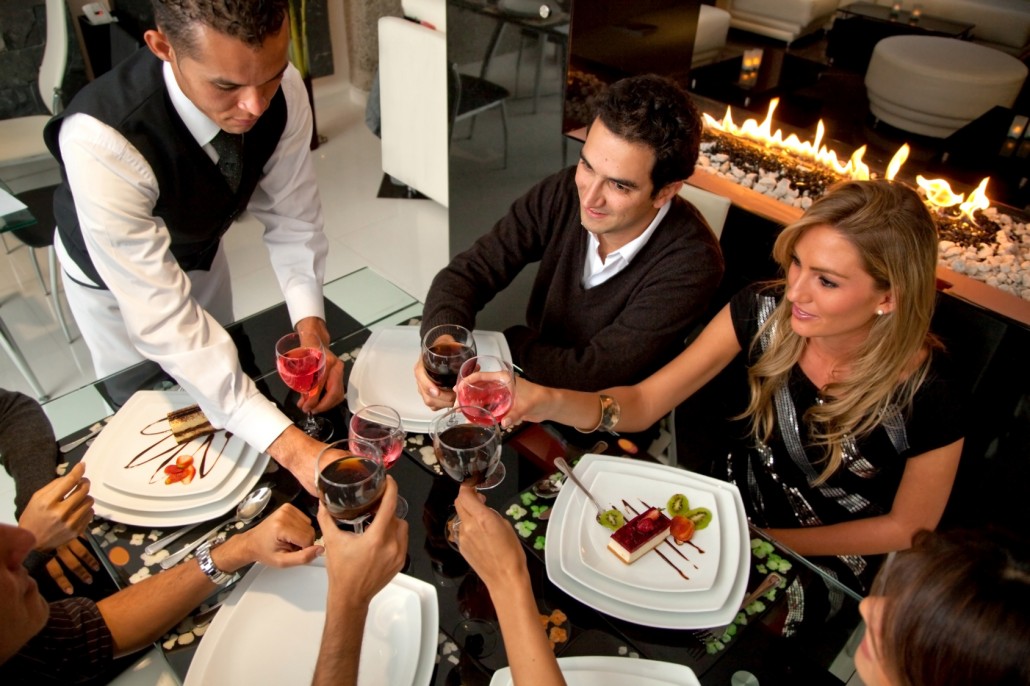When watching your weight, dining out can seem quite a challenge! In fact, many of us dine out more than we ever have in the past, and there is an array of different restaurants available to us.
With all of the different options to choose from, two things seem generally consistent: portions are large, and meals are loaded with starches and unhealthy fats, which can create inflammation, weight gain and many chronic health issues.
However, since there are so many people trying to follow a more health-conscious lifestyle, restaurants are becoming much more accommodating to your needs than ever before.
In this article I will list 9 easy ways to help you eat healthy when dining out. These clever little tips will help keep you on-track with your weight loss efforts and health goals without having to give up your social life.
1. View the Menu Before You Go
If you’re not familiar with the menu, try viewing it online before you get to the restaurant. It is scientifically proven that you are more likely to make unhealthy choices when you are ravenous and/or distracted, so knowing beforehand what’s on the menu will help alleviate those potential distractions that could sway your decision to an unhealthy option. (1, 2)
Equally, just the sight and smell of food can have an abrupt forecast on your decisions, which we all know can make adhering to your healthy regimen more difficult, especially if you’re already in hunger mode. (3)
Learning the menu and making your food choices before you arrive will make it much easier to avoid rash decisions you might regret later.
2. Eat a Small Healthy Snack in Advance
Chances are, if you’re hungry when you arrive at the restaurant, you will most likely end up eating too much of the wrong stuff. One way to prevent this is to calm your hunger by eating a healthy snack before you get there.
A nice, small, high protein snack like peanut butter on celery stalks or a couple ounces of mixed nuts could satiate you enough to prevent you from making a bad decision and eating the whole breadbasket or just plain overeating. (4, 5)
3. Specify how you’d Like Your Food Prepared
The way your food is prepared can have a significant impact on the number of unhealthy calories it contains as well as the food’s inflammatory response which can potentially lead to weight gain or other chronic health issues. (6, 7)
Look for foods that can be steamed, grilled, roasted or poached. In general, these cooking methods equate to less unhealthy processed fats being used, and therefore, lowering the pro-inflammatory response and over-all unhealthy calories. Foods that are described on the menu as pan-fried, fried, crispy, and crunchy or sautéed will usually contain more of these pro-inflammatory fats and more unhealthy calories.
4. Try Ordering First
Believe it or not, other people can have a major influence on our subconscious decision making without us even realizing it. Therefore, in many different social situations, people tend to mimic each other subconsciously, and dining out is no exception to this rule.
Studies suggest that people’s menu choices and eating behaviors can be highly influenced by the choices of others seated around them. (8, 9)
If you’re eating with a group that is likely to order something that doesn’t fit into your healthy eating regimen, make sure you take the initiative to try and order first.
5. Start with a Soup or Salad
Ordering a soup or a salad before your main course can significantly help stop you from over-eating and/or grabbing the unhealthy table add-ons like bread, buns, or crackers and cheese. (10, 11)
Looking over the studies at the effects of eating soup or a salad before having your entree has been shown to reduce your total caloric intake by as much as 20 percent. (12)
Vegetable-based soups are an obvious and great healthy choice. Either this type of soup or reverting to a salad will also help add in more healthy vegetables to your diet.
6. Request Your Sauces and Dressings on the Side
Many of the sauces and dressings we have to choose from can be loaded with a lot of extra unhealthy fat and way more sugar than we’ve bargained for. So, to control these unnecessary “insidious ingredients” always ask for your sauces and dressing on the side.
A great example of this is although two tablespoons of French salad dressing will only add about 60 calories to your meal it adds nearly 10 grams of unnecessary sugar. Keeping it separate will make it much easier to control the amount you eat.
7. Make Healthy Swap-ins
Most people neglect to eat enough vegetables these days. However, I believe that most of us are aware of the amazing health benefits that vegetables bring to our tables including an abundance of fiber and other important nutrients, all while being wrapped in a super low caloric environment. (13, 14)
A great example of this is broccoli and spinach, both of which are super low in calories yet extremely super nutrient dense, sporting plenty of fiber, vitamin, antioxidants and many other beneficial plant compounds.
Increasing one’s vegetable intake has also been linked to a reduced risk factor of weight-gain and obesity, depression and even cancer. (15, 16, 17)
When you order your meal, ask the server to swap-in extra veggies in place of your potato or fries. You’ll boost your vegetable intake while cutting unnecessary calories and insulin spiking starches.
8. Drink Your Water
Water is simply the best beverage for your body hands down. And it’s undoubtedly a fantastic choice for drinking before, during, and after your meal, especially if you normally opt for sugar sweetened beverages instead.
Replacing sugar-sweetened drinks with water can help drastically reduce your intake of unnecessary “insidious induced” calories from added sugar which is commonly linked to weight gain and metabolic issues such as type II diabetes. (18, 19, 20)
One 12-week study done with middle-aged and older adults who were trying to lose weight was shown to increase weight loss by as much as 44 percent when drinking just 500 ml or 17oz of water a half an hour prior to meals. This is a fairly significant amount versus those who did not drink water prior to meals. (21)
If you want to make a healthy drink choice while dining out, stick to water or unsweetened tea.
9. Limit Your Alcohol
Drinking alcohol can add a significant number of “empty” calories (meaning calories with no nutritional value) to your dining experience.
Of course, the number of calories in an alcoholic drink can significantly vary depending on the strength of the alcohol and the size of the drink.
For example, a large glass of red wine which is about 1 cup or 250 ml and 13 percent alcohol by volume, can add as much as 280 calories to your meal. Believe it or not, that’s the same as a Snickers bar.
If you want to enjoy a drink, you can cut back on the extra calories by simply ordering smaller measures, such as a small 4 to 5oz glass of wine.
If you’re opting for a mixed drink with spirits such as gin, vodka or whiskey, try mixing the spirit with a diet drink instead of a sugar-sweetened drink or fruit juice, or an even better option would be to mix it with seltzer or water. Read more on alcohol HERE


